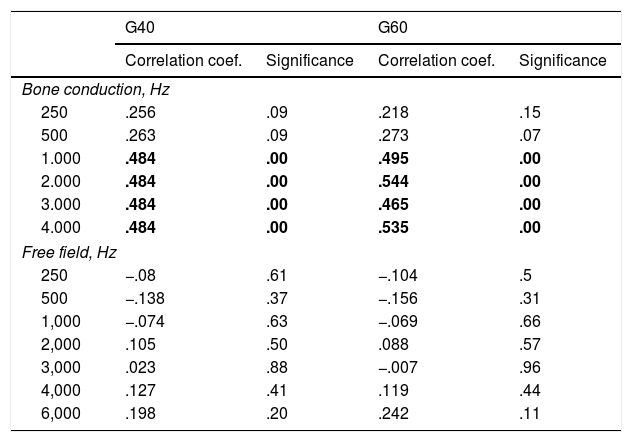Osseointegrated auditory devices are hearing gadgets that use the bone conduction of sound to produce hearing improvement. The mechanisms and factors that contribute to this sound transmission have been widely studied, however, there are other aspects that remain unknown, for instance, the influence of the processor power output. The aim of this study was to know if there is any relationship between the power output created by the devices and the hearing improvement that they achieve.
Materials y methods44 patients were implanted with a percutaneous Baha® 5 model. Hearing thresholds in pure tone audiometry, free-field audiometry, and speech recognition (in quiet and in noise) were measured pre and postoperatively in each patient. The direct bone conduction thresholds and the power output values from the processors were also obtained.
ResultsThe pure tone average threshold in free field was 39.29 dB (SD = 9.15), so that the mean gain was 29.18 dB (SD = 10.13) with the device. This involved an air-bone gap closure in 63.64% of patients. The pure tone average threshold in direct bone conduction was 27.6 dB (SD = 10.91), which was 8.4 dB better than the pure tone average threshold via bone conduction. The mean gain in speech recognition was 39.15% (SD = 23.98) at 40 dB and 36.66% (SD = 26.76) at 60 dB. The mean gain in the signal-to-noise ratio was -5.9 dB (SD = 4.32). On the other hand, the mean power output values were 27.95 dB µN (SD = 6.51) in G40 and 26.22 dB µN (SD = 6.49) in G60. When analysing the relationship between bone conduction thresholds and G40 and G60 values, a correlation from the frequency of 1000 Hz was observed. However, no statistically significant association between power output, functional gain or speech recognition gain was found.
ConclusionsThe osseointegrated auditory devices generate hearing improvement in tonal thresholds and speech recognition, even in noise. Most patients closed the air-bone gap with the device. There is a direct relationship between the bone conduction threshold and the power output values from the processor, but only in mid and high frequencies. However, the relationship between power output and gain in speech recognition is weaker. Further investigation of contributing factors is necessary.
Los dispositivos auditivos osteointegrados utilizan la transmisión del sonido por vía ósea para producir una mejoría auditiva. Los mecanismos y factores que intervienen en esta transmisión han sido ampliamente estudiados, sin embargo, existen otros aspectos que no conocemos, por ejemplo, la influencia que tiene la potencia de salida del procesador. El objetivo principal del estudio fue conocer si existe alguna relación entre la potencia que emiten estos dispositivos y la mejoría auditiva que producen.
Materiales y métodosHemos realizado un estudio en 44 pacientes portadores de un Baha® 5 percutáneo. De cada paciente se obtuvieron los umbrales de vía aérea y ósea en audiometría tonal liminar, en audiometría en campo libre, y en la audiometría verbal en silencio y con ruido de fondo, tanto previamente como posteriormente a la implantación. También se recogieron los umbrales de conducción ósea directa a través del procesador y los valores de ganancia en la potencia de salida del procesador.
ResultadosEl umbral tonal medio en campo libre fue de 39,29 dB (DE = 9,15), obteniendo una ganancia media de 29,18 dB (DE = 10,13) con el uso del dispositivo. Esto supuso el cierre del gap entre vía aérea y ósea en el 63,64% de pacientes. El umbral tonal medio de la conducción ósea directa fue de 27,6 dB (DE = 10,91), lo que supone 8,4 dB menos que el umbral tonal medio de la vía ósea. La ganancia media en inteligibilidad fue del 39,15% (DE = 23,98) para intensidades de 40 dB y del 36,66% (DE = 26,76) para intensidades de 60 dB. La ganancia media en la relación señal-ruido fue de -5,9 dB (DE = 4,32). Por otro lado, los valores medios de potencia de salida fueron de 27,95 dB µN (DE = 6,51) para G40 y de 26,22 dB µN (DE = 6,49) para G60. Al analizar la relación entre los umbrales de vía ósea y los valores de G40 y G60 observamos una correlación en frecuencias a partir de 1000 Hz. Sin embargo, no se encontró una asociación estadísticamente significativa entre las potencias de salida y la ganancia auditiva tonal o la ganancia en inteligibilidad.
ConclusionesLos dispositivos auditivos osteointegrados producen una mejoría auditiva en los pacientes tanto a nivel tonal como en inteligibilidad, incluso con ruido de fondo. La mayoría de los pacientes consiguieron cerrar el gap previo existente entre vía aérea y ósea con el dispositivo. Existe una relación directa entre los umbrales tonales en la vía ósea y los valores de potencia de salida que emite el procesador, aunque solo en frecuencias medias y agudas. Sin embargo, la relación entre la potencia de salida y la mejoría en inteligibilidad en silencio y con ruido de fondo es mucho menor. Más investigaciones en cuanto a factores que puedan influir entre estas variables serían necesarias.














